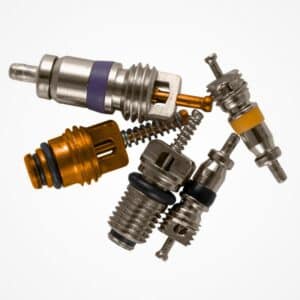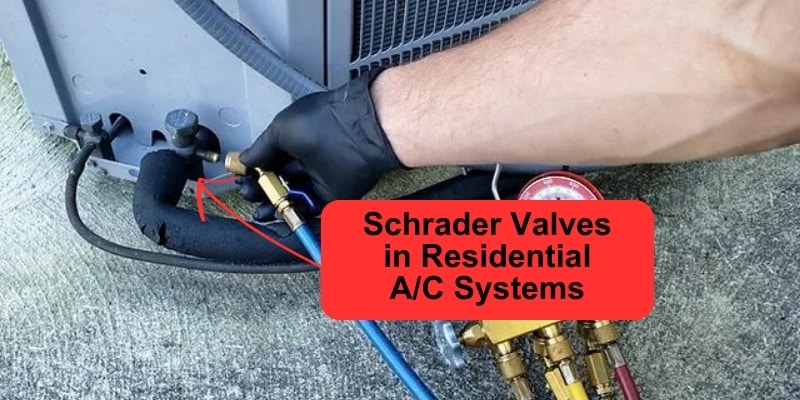There’s a small component in your AC system that plays a crucial role in keeping your home cool: the Schrader valve. This tiny valve ensures the refrigerant remains securely inside your air conditioning unit. If you’ve ever pumped air into a bike tire or been around when a car tire let out a quick whoosh of air, you’ve interacted with a Schrader valve, even if unknowingly.
While the basic mechanics of the Schrader valve, especially the pin and spring, remain fairly consistent across different applications, their sizes can be variable. That means the Schrader valve in a mini-split A/C might be of a different size than what you’d find in a large truck tire.
However, there’s good news for those keen on DIY maintenance. Many universal Schrader core tools are designed to fit the valves in typical air conditioners. But it’s essential to remember that the perfect tool for your home’s A/C might not be the right fit for, say, your bicycle or car tire. So, before you embark on any maintenance or checks, ensure you’re equipped with the right tool for the task.
Dive in with us as we demystify this A/C Schrader valve and offer insights on its maintenance.
What is a Schrader Valve?
What exactly is a Schrader Valve? Often referred to as a service valve or core valve, the Schrader valve is essentially the port that comes into play when servicing an HVAC or air conditioning system. It’s a prevalent component in U.S.-made air conditioning units, motor vehicles, and various other powered equipment.

The specific feature of the Schrader valve is its internal structure: a valve core or shell accompanied by a pin or spring. This design ensures the valve remains shut until intentionally opened with a specific tool; mere pressure isn’t enough to activate its release of air or refrigerant.
The Vital Role of Schrader Valves in Residential A/C Systems
While the Schrader valve may seem little, it’s mighty in function. Think of it as the gatekeeper of your A/C’s refrigerant system. By providing a secure seal, it ensures the refrigerant flows effectively, allowing your home to stay cool during those scorching summer days. Plus, it makes maintenance easier, allowing technicians to check pressures without letting any refrigerant escape.

At the heart of the Schrader valve are two primary elements housed within a unified tool structure. The external part, often referred to as a threaded hollow shell, encompasses the central feature: the poppet valve, which is snugly seated within the hollow shell.
The Schrader valve’s design and mechanism are meticulously crafted, enabling technicians to seamlessly introduce or extract refrigerant or other gases. This structure ensures no unwanted leakages, proving invaluable in high-pressure settings. Intriguingly, these valves mirror those found on car tires. The valve’s core integrates with the springs, permitting the regulated flow of refrigerant or gas whenever the core is engaged.
Common Issues and Maintenance of an AC Schrader Valve
Just like every other component, the Schrader valve isn’t resistant to issues. It can get clogged, freon leak, or even fail. Leaks especially can affect the performance of your A/C, causing it to work harder, leading to more energy consumption.
Take a moment to clear any accumulated dirt or debris around the valve area, especially on its threads. A protective cap usually accompanies your AC’s Schrader valve, which safeguards the threads. Always ensure this cap is in place and free from contaminants. This simple measure can help stave off unnecessary wear, potentially averting any leak issues.
How to Replace a Schrader Valve
If your Schrader valve is acting up, don’t sweat it (literally!). Replacing it is straightforward. To tackle the task of changing a Schrader valve, there’s a designated tool called Schrader or valve extraction tool. This nifty device can vary in design, with some resembling a bent L-shape.
- Prior to initiating the valve switch, it’s paramount to verify that the line is devoid of any refrigerant.
- If refrigerant is present, discharge it conscientiously, adhering strictly to EPA standards and protocols.
- Pinpoint the Schrader valve’s location on your AC unit. Consulting the user guide can be handy if you’re unsure.
- Employ dedicated pliers to carefully unscrew and detach the outer head of the valve.
- Extract the existing Schrader valve with precision using tweezers or a similar instrument.
- Carefully introduce the new valve into its housing with the tweezers, ensuring it’s oriented correctly.
- Re-secure the screw, ensuring it’s snug. A delicate balance is key here – avoid over-tightening or leaving it too slack.
- Replenish the refrigerant and operate the system as you typically would.
How much does it cost to replace an AC Schrader valve?
The Schrader Valve by itself won’t break the bank, typically priced between $5 to $15. However, replacement costs can fluctuate based on the technician’s rates. On average, you might shell out $75 to $100 for a full replacement.
Opting for a DIY approach? Your only expense would be the valve itself, potentially halving your total outlay.
AC’s Schrader Valve vs. Tire’s Schrader Valve: What’s the Difference?
For those with a keen interest in automobiles, the term “Schrader” may sound familiar. That’s because it’s synonymous with the renowned pneumatic tire valve found in a plethora of vehicles. In fact, you’d be hard-pressed to find a bicycle or motorcycle anywhere in the world that doesn’t have a Schrader valve nestled in its tubes or tires.
What’s truly fascinating is the uniformity in its purpose, regardless of where it’s placed. Whether it’s in the midst of a complex AC system or snugly fitted inside a tire, its mission is unwavering: to meticulously manage and maintain air, ensuring not a whiff slips out.
Consider the act of pumping air into a tire. When the valve is pressed, the pin within depresses the rubber component, creating a gateway for the incoming air. However, once you cease the pressure, the spring-loaded seal springs back to action, ensuring the captured air remains trapped, without any avenue for escape.
Tips for Homeowners
For all my DIY enthusiasts out there, here’s a nugget of wisdom: while replacing an AC Schrader valve can be tempting, it’s best to call in professionals when dealing with refrigerants. Not only can mishandling harm the environment, but it can also pose risks to you. And always remember to wear safety gear if you’re poking around your A/C system.
The A/C Schrader valve, tiny as it may seem, plays an undeniable role in keeping our homes chilled and comfortable. By understanding its function and ensuring its proper maintenance, we can enjoy a cool breeze all summer long.






